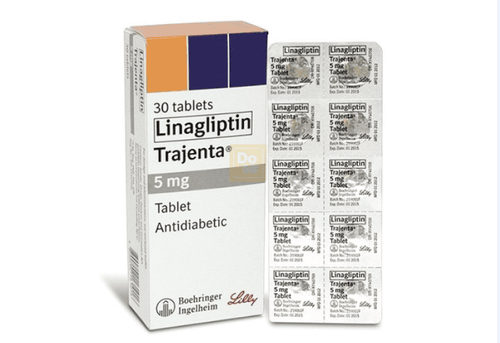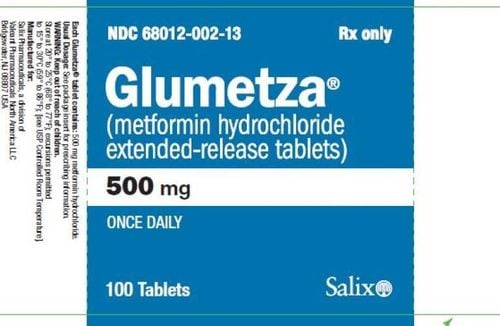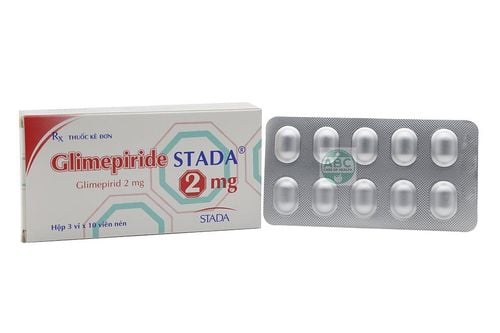This is an automatically translated article.
Lastidyl drug has the active ingredient Glimepiride and other excipients in a sufficient amount. This drug is made in the form of tablets, suitable for direct oral use. This medication is used to treat non-insulin dependent diabetes mellitus (type 2 diabetes) in adults.1. What is Lastidyl?
What is Lastidyl? Lastidyl drug has the main active ingredient Glimepiride and other excipients in a sufficient amount. This drug is in the form of tablets, suitable for direct oral use. Packing is a box of 3 blisters and each blister contains 10 tablets. This medication is used to treat non-insulin dependent diabetes mellitus (type 2 diabetes) in adults.
Main active ingredient Glimepiride is a sulphonamide used orally, with blood glucose-lowering effects, belonging to the sulfonylurea group. The main action of Glimepiride is to stimulate the release of insulin from the beta cells of the islets of Langerhans of the pancreas.
The active ingredient Glimepiride has a very high bioavailability. Daily food does not significantly change the absorption of the drug, but the rate of absorption is slower. Maximum plasma concentrations are reached on average 2 hours and 30 minutes after dosing.
Glimepiride is excreted in milk in animal studies. It crosses the placenta-fetal barrier, but the blood-brain barrier is very poor.
2. What disease does Lastidyl treat?
Lastidyl is used in the treatment of the following pathologies:
Lastidyl is used orally to treat non-insulin dependent diabetes mellitus (type 2 diabetes) in adults, when blood levels are not controlled. blood sugar with diet, exercise and weight loss. Lastidyl can be used in combination with Metformin or Glitazone or with insulin.
3. Usage and dosage of Lastidyl
3.1. How to use Lastidyl Lastidyl drug is prepared in the form of tablets, suitable for direct oral use. Lastidyl is taken once a day, either before or right in the morning with a large meal, or right before the first main meal of the day. Swallow the tablet whole, without chewing, with about half a cup of water. 3.2. Dosage of Lastidyl Dosage depends on the blood sugar level, response and tolerance of the patient. The lowest dose of medication that achieves the desired blood glucose level should be used. The starting dose should be 1 mg/day. Then, every 1-2 weeks, if blood glucose is not controlled, increase the dose by 1mg/day, until blood glucose is controlled. The maximum dose of Glimepiride is 8 mg/day. Usually patients respond to doses of 1-4 mg/day, rarely to 6 or 8 mg/day. Doses higher than 4 mg/day only have better results in some special cases. The user should never take a dose to make up for a missed dose. If it is discovered that a large dose has been used or an excess dose is taken, it is necessary to notify the treating doctor immediately to solve it before the appearance of overdose symptoms. 3.3. Cases that require dose adjustment In some specific cases, the treating doctor may prescribe a change in the therapeutic dose, specifically as follows:
If after taking 1 mg of glimepiride, there is a phenomenon of hypoglycaemia blood, that patient can only need to be treated with diet and daily exercise. When the disease is controlled, blood glucose stabilizes, insulin sensitivity improves, so the need for the active ingredient Glimepiride may decrease after treatment for some time. The dose of Glimepiride should be changed to avoid hypoglycemia when: The patient's weight changes. The patient's lifestyle changes. There are combinations with medications or factors that can raise or lower blood sugar. Decreased liver and kidney function
4. Lastidyl overdose case
4.1. Signs and symptoms of Lastidyl overdose In the case of an overdose of Lastidyl, it leads to hypoglycemia with signs and symptoms such as:
Systemic signs: The user has a feeling of physical and mental fatigue. , drowsiness, dizziness, sweating. These are very important signs during this period). For the digestive system: Feeling of hunger and epigastric cramps, possibly vomiting or diarrhea. For the cardiovascular system: increased palpitations, arrhythmias, tachycardia or extrasystoles; High Blood Pressure; precordial pain with arrhythmia or angina pattern. As for the respiratory system, asthma-like shortness of breath occurs. For the nervous system will appear cramps, paresthesia of the extremities and around the lips, frequent or paroxysmal headache; accommodation disorder, double vision, chills (easily mistaken for an infection). In addition, the person who overdosed on the drug showed additional signs and symptoms for the nervous system such as specific personality disorders such as irritability, cheerfulness or sometimes sadness or anger. In severe cases, the clinical picture of severe hypoglycaemia can resemble a stroke and may not appear until 24 hours after ingestion. 4.2. How to handle Overdose drug Lastidyl Mild case: Users need to drink glucose or white sugar 20-30g mixed in a glass of water and monitor blood sugar. Give it once every 15 minutes, until the blood sugar returns to normal. Severe cases: People who overdose on the drug may become comatose or unable to drink, must immediately inject 50ml of glucose solution. Give once every 15 minutes, until blood glucose returns to normal limits. Blood glucose should be continued to be monitored for up to 24 to 48 hours, because it is easy to develop recurrent hypoglycaemia. If the case is too severe, the doctor may prescribe glucagon 1mg injected under the skin or muscle. If taking too much medication containing Glimepiride, the treating doctor will prescribe gastric lavage and activated charcoal.
5. Undesirable effects of the drug Lastidyl
The most important side effect of Lastidyl is hypoglycemia. When hypoglycemia occurs, it should be done as in the section “In case of overdose of Lastidyl”.
Common side effects with frequency of ADR > 1/100 Nervous: dizziness, dizziness, headache. Gastrointestinal: nausea, vomiting, pain in the epigastrium, abdominal pain accompanied by diarrhea. Eyes: when starting to use the drug often temporary visual disturbances, due to changes in the level of glucose in the blood. Uncommon side effects with frequency 1/1000 < ADR < 1/100: allergic or desensitized reactions, redness, urticaria, pruritus Rare side effects with frequency > 1/1000 Liver: increased liver enzymes, jaundice, impaired liver function. Blood: mild or severe thrombocytopenia, hemolytic anemia, decreased red blood cell count, decreased white blood cell count, agranulocytosis. Vascular: allergic vasculitis. Skin: increased sensitivity to light.
6. Lastidyl drug interactions
Drugs that have the potential to increase the hypoglycemic effect of Lastidyl such as insulin, other drugs that lower blood glucose, chloramphenicol, coumarin derivatives, cyclophosphamide, disopyramide, ifosfamide, non-steroidal anti-inflammatory drugs, probenecid, miconazole , Quinolones, Sulfamides, beta-blockers, ACE inhibitors, anabolic steroids and male sex hormones. When one of the above drugs is combined with Lastidyl, there may be a very dangerous risk of hypoglycemia. At that time, the treating doctor will appoint to adjust and reduce the dose of glimepiride. Drugs that increase blood glucose in combination with Lastidyl, Corticosteroids, Diazoxide, Catecholamines and other sympathomimetic drugs, Glucagon, nicotinic acid (high dose), Estrogen and oral contraceptives contain ingredients Estrogen, phenothiazine, phenytoin, thyroid hormone, Rifampicin. When one of the above drugs is combined with Lastidyl, it can lead to an increase in blood glucose. At that time, the treating doctor will prescribe an increase in the dose of Glimepiride.
7. Some notes when using Lastidyl
7.1. Contraindications of Lastidyl Do not use Lastidyl in people with insulin-dependent diabetes mellitus (type 1 diabetes mellitus), diabetic ketoacidosis, pre-coma or coma due to diabetes. diabetic coma, diabetic coma, and other acute illnesses. In these cases, insulin is required. Do not use Lastidyl with people with severe kidney failure, severe liver failure, people who are pregnant or want to become pregnant, nursing mothers. Particularly for women who are breastfeeding, if they stop breastfeeding, they can take Lastidyl. People who are sensitive to the main active ingredient Glimepiride, who have ever been allergic, sensitive to Sulfamide, or sensitive to a certain ingredient in the drug. 7.2. Precautions when using Lastidyl For all patients, it is necessary to explain to the patient that despite using Lastidyl, it is still necessary to strictly follow a diet combined with reasonable exercise. It is necessary to inform the patient and the patient's family about the causes, symptoms and treatment of hypoglycemic events. Glimepiride, like other sulfonylureas, can cause hypoglycemia. Patients with poor nutrition, adrenal insufficiency, liver failure, pituitary failure, especially kidney failure are very likely to drop blood sugar when using Lastidyl. Patients who are stabilized on Lastidyl therapy may become uncontrollable under stress, trauma, surgery, infection, and high fever. At that time, the treating doctor usually prescribes the use of insulin in combination with drugs containing the active ingredient Glimepiride or insulin alone instead of Glimepiride. Using Lastidyl as well as taking other oral hypoglycemic drugs, although blood glucose control is achieved, after a period of time, blood glucose control may no longer be controlled. At that time, the dose must be increased or combined with Metformin, Glitazone or with insulin. When taking Lastidyl, blood sugar levels can become unstable, especially at the start, or when therapy is changed or when taken at irregular intervals, causing a patient's flexibility or responsiveness to decrease. This affects the ability to drive and use machines. Particular attention should be paid to hypoglycaemia in the elderly and those taking beta-blockers or sympathomimetic drugs, as it is difficult to detect. If there is a drop in blood sugar, it must be treated promptly. It is necessary to periodically monitor blood sugar levels and measure HbA1c every 3 to 6 months to change the treatment regimen if necessary. Store Lastidyl in a dry place, at a temperature of 15 - 30 degrees Celsius in tightly closed containers, away from moisture and away from direct light. In addition, lastidyl should be kept out of reach of children and household pets. Never use Lastidyl after the expiry date.
Patients need to carefully read the instructions for use, consult a doctor / pharmacist before using the drug. Absolutely do not arbitrarily buy Lastidyl drugs to treat diseases at home, because there may be unwanted side effects to health.













